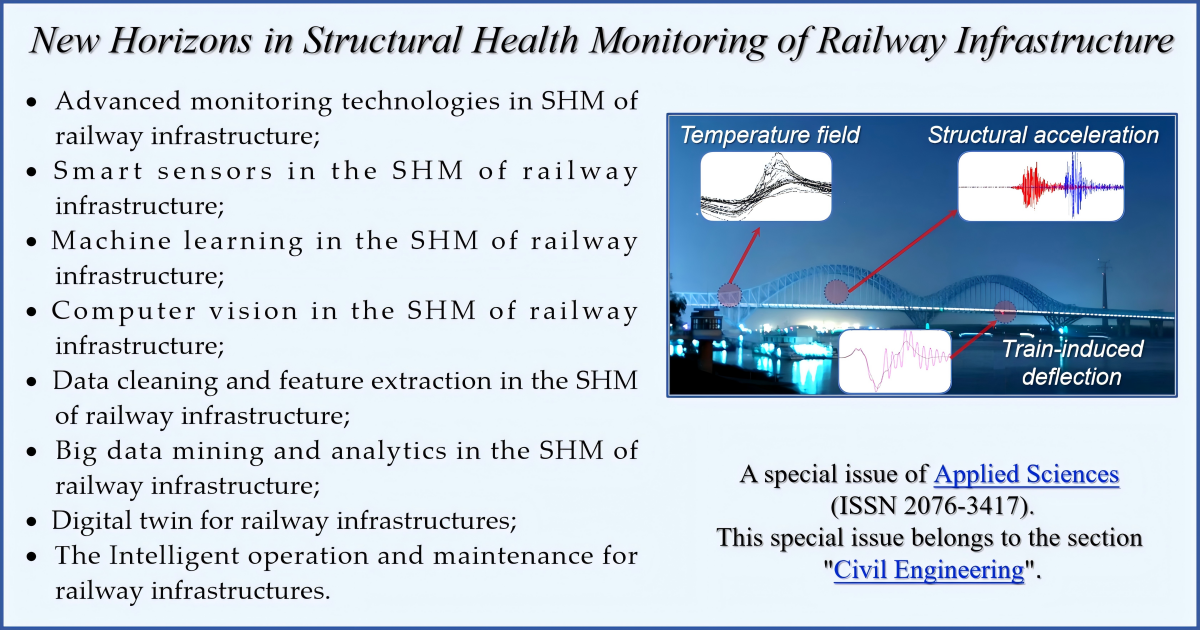New Horizons in Structural Health Monitoring of Railway Infrastructure
A special issue of Applied Sciences (ISSN 2076-3417). This special issue belongs to the section "Civil Engineering".
Deadline for manuscript submissions: 31 December 2026 | Viewed by 944

Special Issue Editors
Interests: structural health monitoring; structural dynamics; data mining and analytics
Special Issues, Collections and Topics in MDPI journals
Interests: structural health monitoring; data mining and analytics; structural condition assessment
Interests: structural health monitoring; structural design theory of bridges
Interests: structural health monitoring; AI-based schemes for damage detection and signal processing; system identification; smart operation and maintenance for civil engineering structures
Special Issue Information
Dear Colleagues,
Since the 1970s, structural health monitoring (SHM) systems have been applied to bridges and buildings in civil engineering, but their gradual adoption and refinement for railway infrastructure has only happened more recently. SHM systems deploy sensors at critical structural locations to monitor environmental effects, structural responses, and real-time changes, providing an essential source of data for analyzing the condition of railway infrastructure. The evolution of the structural performance of railway infrastructure becomes highly complex over its service life due to the influence of harsh environmental conditions (such as typhoons and earthquakes), train loads, and corrosion-induced aging. As a result, the operation and maintenance of existing railway infrastructure face significant challenges. Developing advanced monitoring technologies, establishing efficient data processing methods, and devising condition assessment approaches are of great significance for ensuring the SHM of railway infrastructure.
By applying advanced monitoring technologies and new-generation information technologies such as artificial intelligence and big data, it is possible to more comprehensively monitor the behavior of railway infrastructure under external loads, effectively enhancing our ability to extract valuable insights from monitoring data, identify the evolving patterns of the infrastructure’s operating conditions, and provide a scientific basis for making informed decisions to ensure the safe and reliable service of railway infrastructure.
Therefore, this Special Issue seeks original research or review articles the focus on new horizons in the SHM of railway infrastructures, such as advanced monitoring technologies and AI applications. The Special Issue is intends to include (but is not limited to) the following topics:
- Advanced monitoring technologies in the SHM of railway infrastructure;
- Smart sensors in the SHM of railway infrastructure;
- Machine learning in the SHM of railway infrastructure;
- Computer vision in the SHM of railway infrastructure;
- Data cleaning and feature extraction in the SHM of railway infrastructure;
- Big data mining and analytics in the SHM of railway infrastructure;
- Digital twins for railway infrastructure;
- The intelligent operation and maintenance of railway infrastructure.
Dr. Hanwei Zhao
Dr. Zhenwei Zhou
Dr. Zi-Xiang Yue
Dr. Chunfeng Wan
Guest Editors
Manuscript Submission Information
Manuscripts should be submitted online at www.mdpi.com by registering and logging in to this website. Once you are registered, click here to go to the submission form. Manuscripts can be submitted until the deadline. All submissions that pass pre-check are peer-reviewed. Accepted papers will be published continuously in the journal (as soon as accepted) and will be listed together on the special issue website. Research articles, review articles as well as short communications are invited. For planned papers, a title and short abstract (about 250 words) can be sent to the Editorial Office for assessment.
Submitted manuscripts should not have been published previously, nor be under consideration for publication elsewhere (except conference proceedings papers). All manuscripts are thoroughly refereed through a single-blind peer-review process. A guide for authors and other relevant information for submission of manuscripts is available on the Instructions for Authors page. Applied Sciences is an international peer-reviewed open access semimonthly journal published by MDPI.
Please visit the Instructions for Authors page before submitting a manuscript. The Article Processing Charge (APC) for publication in this open access journal is 2400 CHF (Swiss Francs). Submitted papers should be well formatted and use good English. Authors may use MDPI's English editing service prior to publication or during author revisions.
Keywords
- railway infrastructure
- structural health monitoring
- AI
- monitoring technology
- data mining
- condition assessment
Benefits of Publishing in a Special Issue
- Ease of navigation: Grouping papers by topic helps scholars navigate broad scope journals more efficiently.
- Greater discoverability: Special Issues support the reach and impact of scientific research. Articles in Special Issues are more discoverable and cited more frequently.
- Expansion of research network: Special Issues facilitate connections among authors, fostering scientific collaborations.
- External promotion: Articles in Special Issues are often promoted through the journal's social media, increasing their visibility.
- Reprint: MDPI Books provides the opportunity to republish successful Special Issues in book format, both online and in print.
Further information on MDPI's Special Issue policies can be found here.








